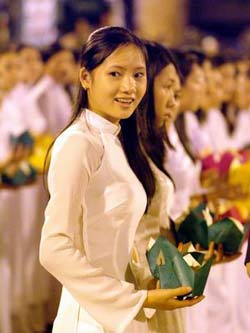You probably know that we're in Ho Chi Minh City in Vietnam right now. The Culture and nature are magnificant!
During French colonial period, Vietnamese culture received merchant influences from the Europeans, including the spread of Catholicism and the adoption of Latin alphabet. To this day, Vietnam is the only nation of Indochina which uses the Latin alphabet to write the national language.
Some elements generally considered to be characteristic of Vietnamese culture include ancestor veneration, respect for community and family values, handicrafts and manual labour, and devotion to study. Important symbols present in Vietnamese culture include dragons,turtles, lotuses and bamboo.

The Kinship or Vietnamese family plays an important role in Vietnam. Unlike Western culture's emphasis on individualism, Eastern culture values the roles of family and clanship. Comparing with Eastern cultures, Chinese culture values family over clan while Vietnamese culture values clan over family.
Religion in Vietnam has historically been defined by the East Asian mix of Buddhism, Confucianism, and Taoism. It is locally known as the Tam Giáo, or "triple religion."
Vietnamese Buddhism has typically been the most popular which fits perfectly with the "triple religion" concept, making it difficult for many Vietnamese to identify exactly which religion they practice.
Vietnamese cuisine is extremely diverse, often divided into three main categories, each pertaining to Vietnam's three main regions (north, central and south). It uses very little oil and many vegetables, and is mainly based on rice, soy sauce, and fish sauce. Its characteristic flavors are sweet, spicy, sour and
nuoc mam (fish sauce)
Vietnam also has a large variety of noodles and noodle soups.
Vietnamese phở
(noodle soup with sliced rare beef and well done beef brisket)
 In Vietnam, clothing is one of the most important marks of social status and strict dress codes were enforced.
In Vietnam, clothing is one of the most important marks of social status and strict dress codes were enforced.Commoners had a limited choice of similarly plain and simple clothes for every day use, as well as being limited in the colors they were allowed to use.
The headgear of peasants often included a plain piece of cloth wrapped around the head called Khăn đống, or another headgear is the popular Nón Lá. For footwear peasants would often go barefoot, whereas sandals and shoes were reserved for the aristocracy and royalty.
Monarchs had the exclusive right to wear the color gold, while nobles wore red or purple.
The most popular and widely-recognized Vietnamese national costume is the Áo Dài. Áo Dài was once worn by both genders but today it is worn mainly by females,
In daily life, the traditional Vietnamese styles are now replaced by Western styles. Traditional clothing is worn instead on special occasions, with the exception of the white Áo Dài commonly seen with high school girls in Vietnam.
Martial arts

Vovinam demonstration in Germany.
Vietnamese martial arts is highly developed from the country's very long history of warfare and attempts to defend itself from foreign occupation. Although most heavily influenced by Chinese martial arts, it has developed its own characteristics throughout the millennia in combination with other influences from its neighbours.
The general Vietnamese term for martial arts is "Võ-Thuật." Some of the more popular include:
After we completed the museum tour we moved to the northwest of the city in Củ Chi district. There we went into The Củ Chi tunnels.



The last day in Ho Chi Minh City we went to Cần Giờ's Eco beach resort. This is one of the three recreational sites inside the city which are popular for tourists. The other 2 sites are The Đầm Sen Tourist and its Cultural Park plus Suối Tiên Amusement and its Culture Park.

Monarchs had the exclusive right to wear the color gold, while nobles wore red or purple.
The most popular and widely-recognized Vietnamese national costume is the Áo Dài. Áo Dài was once worn by both genders but today it is worn mainly by females,
In daily life, the traditional Vietnamese styles are now replaced by Western styles. Traditional clothing is worn instead on special occasions, with the exception of the white Áo Dài commonly seen with high school girls in Vietnam.
Martial arts
Vovinam demonstration in Germany.
Vietnamese martial arts is highly developed from the country's very long history of warfare and attempts to defend itself from foreign occupation. Although most heavily influenced by Chinese martial arts, it has developed its own characteristics throughout the millennia in combination with other influences from its neighbours.
The general Vietnamese term for martial arts is "Võ-Thuật." Some of the more popular include:
After we completed the museum tour we moved to the northwest of the city in Củ Chi district. There we went into The Củ Chi tunnels.
Vietnam is definitely one of the most interesting cities that we've visited so far.
Again, thanks for the support and keep following us!
Grtz Klaas
Geen opmerkingen:
Een reactie posten